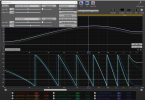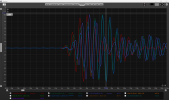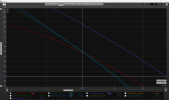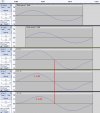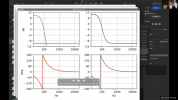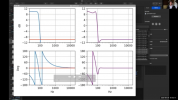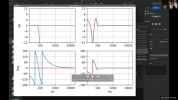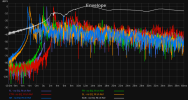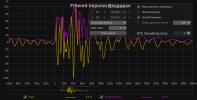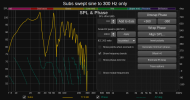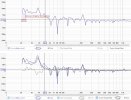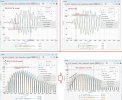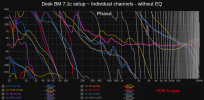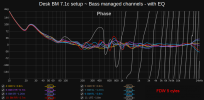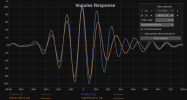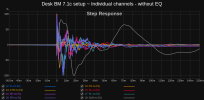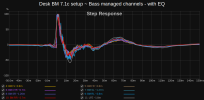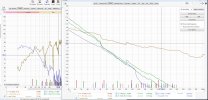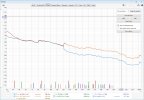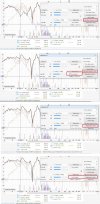If anyone is willing to leverage their expertise to write a guide on how to level-match and phase-align multiple subwoofers to mains from the perspective that an enthusiast will start from scratch and be applying crossovers, EQ, delays, etc..., I would be incredibly appreciative and I get a feeling that the community would benefit tremendously from it.
Really interesting and important point you are raising, I assume.
I am very sorry, however, I myself would not be properly (or never well) responding to your inquiry, and I feel there would be no single solution nor single "golden gate"...

In my DSP-based multichannel multi-SP-Driver multi-amplifier fully active stereo audio project (please find
here the latest setup as on August 3 2023), I have independent L&R sub-woofers (
SWs), L&R woofers (
WOs), Be(Beryllium)-midrange-squawkers (
SQs), Be-dome-tweeters (
TWs), and metal-horn-super-tweeters (
STs); actually 5-way 10-Ch system/setup, where of course I can control all of the 10-Ch gains and delays (phases) independently using DSP as well as in multichannel DAC unit (DAC8PRO), also in analog level using each of the integrated-amps; the active
SW also has its own volume, low-pass crossover and phase-reverse switch.
At least based on my limited (but intensive) experiments and experiences, my present
"personal best suggestion" as of today would be to use suitably prepared (and well QC-ed)
8-wave, 3-wave, 1-wave "sine pulse tone bust test signals" of various Fq for room air-sound recording using
single measurement microphone at your listening position, and to analyze the recorded room air sound by using Adobe Audition's
time-amplitude spectrum and more importantly
3D-color spectrum representing time-gain-Fq in one diagram hopefully using independent separate PC (or MAC); you may/should also "record" the same test tone signal in digital-level and/or analog-line-level for comparative analysis with the recorded room air sound.
One of the wonderful pros of this approach is that, using DSP's flexible "mute" and "play" buttons for each channel (or using each of the integrated amps), we can play-and-record any of the single, and any combination of, all the channels available (in my case L&R total 10-Ch).
As you may easily guess, we have almost infinity number of combinations;
e.g. even if limited only to
SW and
WO, L-SW only,
R-SW only,
L-WO only,
R-WO only, L-SW + R-SW,
L-WO +R-WO,
L-SW + L-WO,
R-SW + R-WO,
L-SW + L-WO + R-SW + R-WO,
etc., etc.
Recordings and measurements of the test tone sound in
L-only R-only and
L+R are always needed since our home listening room is never to be anechoic and never to be physically symmetrical L-to-R and Up-to-Down.
The selection of Fq for the tone burst sine wave (8-, 3,- 1-wave) signals would be also critical depending on your SP drivers and your XO Fq/slope. Whatever the two filter slopes at XO Fq would be, we have more or less Fq zone where both of the XO-ed two SP drivers sing together, and therefore the recording and measurement/analysis at
"XO Fq" and "around (lower and higher) XO fq" would be critical for better-to-best tuning of "gain and phase (time alignment)" matching/tuning.
By very carefully observing/analyzing such 2D-gain-time-spectrum and 3D-color-spectrum which give you not only
"recorded air sound wave shapes" of the test tone but also
"sound energy distribution" (a kind of my terminology) in 3D (time-gain-Fq) space, we can get very much useful invaluable information for better-best tuning of
gain matching,
selection of XO Fq, selection of XO slopes, as well as
phase/delay/time-alignment. Please find
here and
here two of simple but the best typical example cases for what I mean.
As you know well, however, all of
gain, XO Fq, XO slopes, delay/phase/time-alignment are not fully independent, and all of them are more-or-less interdependent with each other. Consequently, we need to find acceptable better-best
"compromised combination" of these parameters in our own audio setup in our actual home room environment.
I actually did such recording and analysis so many times with various combinations of my excellent singers (SP drivers) and DSP parameters, and I shared only the limited essence of my approach on my project thread as follows;
- Precision measurement and adjustment of time alignment for speaker (SP) units: Part-1_ Precision pulse wave matching method: #493
- Precision measurement and adjustment of time alignment for speaker (SP) units: Part-2_ Energy peak matching method: #494
- Precision measurement and adjustment of time alignment for speaker (SP) units: Part-3_ Precision single sine wave matching method in 0.1 msec accuracy: #504,
#507
- Measurement of transient characteristics of Yamaha 30 cm woofer JA-3058 in sealed cabinet and Yamaha active sub-woofer YST-SW1000: #495,
#497,
#503,
#507
- Identification of sound reflecting plane/wall by strong excitation of SP unit and room acoustics: #498
EDIT: Through these primitive but easy-to-understand straightforward measurements/tunings, you can gradually accumulate your understandings/insights on what would be the internal (rather black-box?) automatic procedures in advanced DSP/tuning software such as REW and EqualizerAPO. You would please note that such advanced software would not always gives you proper/correct tuning information as @zergxia kindly shared here on my project thread.
Of course our room does greatly "matter" for our audio sound quality; just for example,
- Not only the precision (0.1 msec level) time alignment over all the SP drivers but also SP facing directions and sound-deadening space behind the SPs plus behind our listening position would be critically important for effective (perfect?) disappearance of speakers: #687
Furthermore, you (we) always should
not over-trust objective measurements and tuning; for the final decision on any of our tuning goals, we should
trust our ears and brain based on your hearing and music preferences. This is also very important in measuring/tuning/deciding your best Fq response "house curve" all throughout 20 Hz to 22 kHz (ref. recent valuable discussions on
this thread;
post #419 and thereafter).
And hopefully you would better to implement flexible on-the-fly relative gain (tone) control mechanisms for your "Fq response housecurve(s)", just I have done in my project.
In this context, I believe it is very important having your/our own
preferable and consistent "audio reference/sampler music playlist and the intact music tracks thereof" throughout your audio exploration and tuning. Please refer to my
summary post here and
here for my own "audio reference/sampler music playlist".
If you would be seriously interested in the test tone signals I prepared for my measurement/tuning, and/or intact tracks of
my "audio sampler reference/sampler playlist", I would be more than happy sharing them personally with you. If this would be the case, please simply PM me writing your wish.


